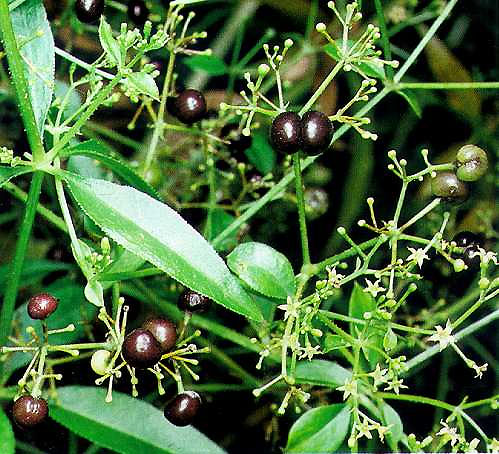- Madder
Taxobox
name = Madder

image_width = 250px
image_caption = Common Madder ("Rubia tinctorum")
regnum =Plant ae
divisio = Magnoliophyta
classis = Magnoliopsida
ordo =Gentianales
familia =Rubiaceae
tribus =Rubieae
genus = "Rubia"
genus_authority = L.
subdivision_ranks = Species
subdivision = See text.Madder is the common name of the
plant genus "Rubia", the type genus of the madder familyRubiaceae . The genus contains about 60 species of perennial scrambling or climbingherb s andsub-shrub s native to theOld World , Africa, temperate Asia and America. The best known species are Common Madder ("Rubia tinctorum"), Wild Madder ("Rubia peregrina"), and Indian Madder ("Rubia cordifolia").The Common Madder can grow to 1.5 m in height. The
evergreen leaves are 5-10 cm long and 2-3 cm broad, produced in whorls of 4-7 starlike around the central stem. It climbs with tiny hooks at the leaves and stems. The flowers are small (3-5 mm across), with five pale yellow petals, in denseraceme s, and appear from June to August, followed by small (4-6 mm diameter) red to black berries. Theroot s can be over a metre long, up to 12 mm thick and the source of a reddye known asrose madder . It prefers loamy soils with a constant level of moisture. Madders are used as food plants for thelarva e of someLepidoptera species including Hummingbird hawk moth.pecies
* "Rubia akane"
* "Rubia alaica" Pachom.
* "Rubia angustifolia" L.
** "Rubia angustifolia" ssp. "angustifolia"
** "Rubia angustifolia" ssp. "caespitosa"
* "Rubia chinensis" Regel & Maack
* "Rubia chitralensis" Ehrend.
* "Rubia cordata" Thunb
* "Rubia cordifolia" L. : Indian Madder
* "Rubia cretacea" Pojark.
* "Rubia deserticola" Pojark.
* "Rubia dolichophylla" Schrenk
* "Rubia florida" Boiss.
* "Rubia fruticosa"
* "Rubia jesoensis" (Miq.) Miyabe & Miyake
* "Rubia komarovii" Pojark.
* "Rubia krascheninnikovii" Pojark.
* "Rubia laevissima" Tscherneva
* "Rubia laxiflora" Gontsch.
* "Rubia pavlovii" Bajtenov & Myrz.
* "Rubia peregrina" L. : Wild Madder
* "Rubia rechingeri" Ehrend.
* "Rubia regelii" Pojark.
* "Rubia rezniczenkoana" Litv.
* "Rubia rigidifolia" Pojark.
* "Rubia schugnanica" B.Fedtsch. ex Pojark.
* "Rubia sikkimensis" Kurz
* "Rubia syrticola" Miq.
* "Rubia tatarica" (Trevir.) F.Schmidt
* "Rubia tibetica" Hook.f.
* "Rubia tinctorum" L. : Common Madder
* "Rubia transcaucasica" Grossh.
* "Rubia yunnanensis" (Franch. ex Diels) DielsUses
It has been used since ancient times as a vegetable red
dye for leather, wool, cotton and silk. For dye production, the roots are harvested in the first year. The outer brown layer gives the common variety of the dye, the lower yellow layer the refined variety. The dye is fixed to the cloth with help of amordant , most commonlyalum . Madder can be fermented for dyeing as well (Fleurs de garance). InFrance , the remains were used to produce a spirit as well.The roots contain the acid
ruberthyrin . By drying, fermenting or a treatment with acids, this is changed to sugar,alizarin andpurpurin . Purpurin is normally not coloured, but is red when dissolved in alcalic solutions. Mixed with clay and treated withalum andammonia , it gives a brilliant red colourant (madder lake ).The pulverised roots can be dissolved in
sulfuric acid , which leaves a dye calledgarance (the French name for madder) after drying. Another method of increasing the yield consisted of dissolving the roots in sulfuric acid after they had been used for dyeing. This produces a dye calledgaranceux . By treating the pulverized roots with alcohol,colorin was produced. It contained 40-50 times the amount ofalizarin of the roots.The chemical name for the
pigment isalizarin , of theanthraquinone -group. In 1869, the German chemists Graebe and Liebermann synthesised artificial alizarin, which was produced industrially from 1871 onwards, which effectively put an end to the cultivation of madder. In the 20th century, madder was only grown in some areas of France.History
Dioscorides and
Pliny the Elder (De Re Natura) mention the plant (Rubia passiva). InViking age levels ofYork , remains of bothwoad and madder have been excavated. The oldest textiles dyed with madder come from the grave of theMerovingian queenArnegundis inSt. Denis nearParis (between 565 and 570 AD). In the "Capitulare de villis" ofCharlemagne , madder is mentioned as "warentiam". Theherbal ofHildegard of Bingen mentions the plant as well. The red coats of the BritishRedcoat s were dyed with madder.According to Culpeper's
herbal , the plant is ruled byMars and has an opening quality, and will bind and strengthen afterwards. It was used in the treatment ofjaundice , obstruction of thespleen ,melancholy ,palsy , haemorrhoids,sciatica , and of bruises. The root should be boiled in wine, and sugar or honey added. The seed of madder, drunk with vinegar and honey is used for the swelling of the spleen. Leaves and stems are used when the monthly female menstrual bleeding is late. Leaves and roots are squashed and put on freckles and other discolorations of the skin.References
* R. Chenciner, Madder red: a history of luxury and trade (Richmond 2000).
External links
* [http://www.mannamcarpets.com/images/madderR3.gifPicture showing shades of red obtained on wool with Madder]
* [http://www.rugreview.com/13-3nest.htm Article showing the results of cold dyeing wool with madder]
* [http://www.dyeplants.de/faerberroete.html Data sheet with pictures of madder] (German)
Wikimedia Foundation. 2010.
